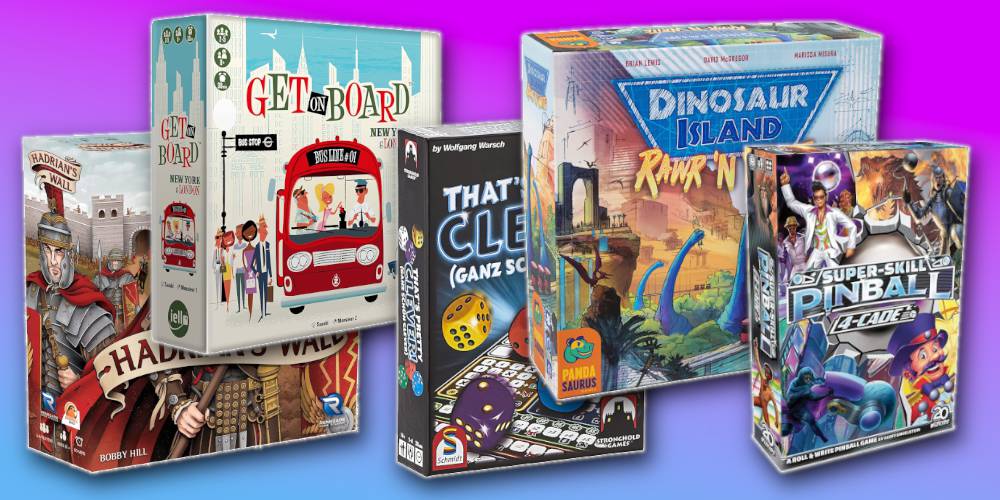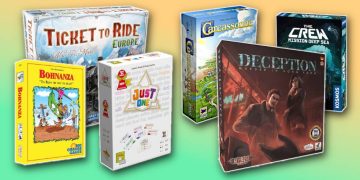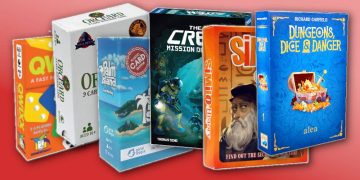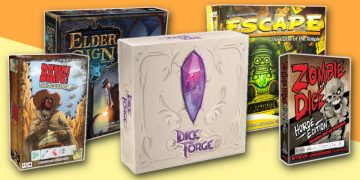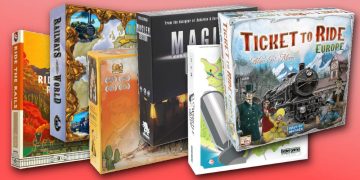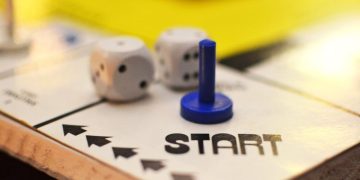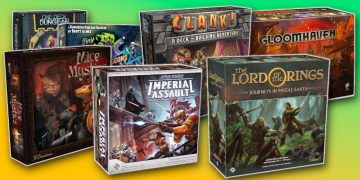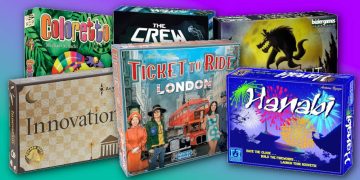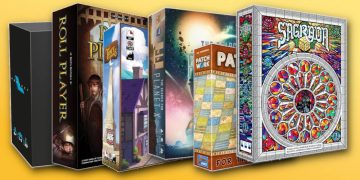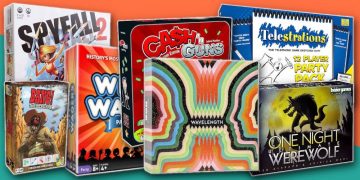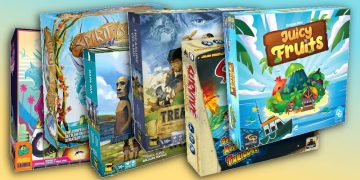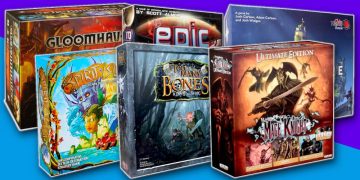When you think of board games, you probably think of games that are mainly played by moving pieces on a board, managing cards in your hand, and maybe even rolling dice for results.
But in recent years, there's been an explosion in popularity of board games that play in a totally different way: with paper and pencil. (Or, more recently, with dry erase markers and boards.)
Sometimes called roll-and-write games or flip-and-write games, these paper-and-pencil games often involve being presented with some information (dice results, card flips, etc.) and deciding what you want to do with that information by marking your own sheet in some way.
What's the appeal of paper-and-pencil games? Well, seeing your marked-up sheet at the end of the game and comparing it with everyone else's is fascinating. Moreover, the physical act of writing on a sheet and seeing it evolve is uniquely satisfying.
But perhaps the best thing about (most) paper-and-pencil games is that they generally need less space to play. You may need a small area for rolling dice or flipping cards, otherwise you can play right in your lap.
Here are the best paper-and-pencil games that showcase how vastly varied (and fun) this board game genre can be.
11. Get on Board: New York & London
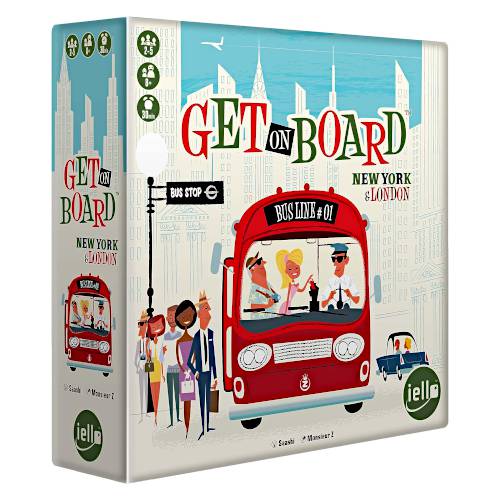
Right off the bat, Get on Board: New York & London is unique compared to most paper-and-pencil games because it actually involves a central board where players move pieces around.
However, players also have their own personal sheet of paper that they'll be marking off as they move around the board.
Every round, a card is flipped which determines how you can move your bus around the city. The goal is to pick up different passengers and drop them off at destinations for points.
Each passenger type has their own scoring mechanic, so it's up to you to decide who you're going to pick up as you move around the city to maximize your scoring opportunities. It's pretty simple but very fun!
10. Dungeons, Dice & Danger
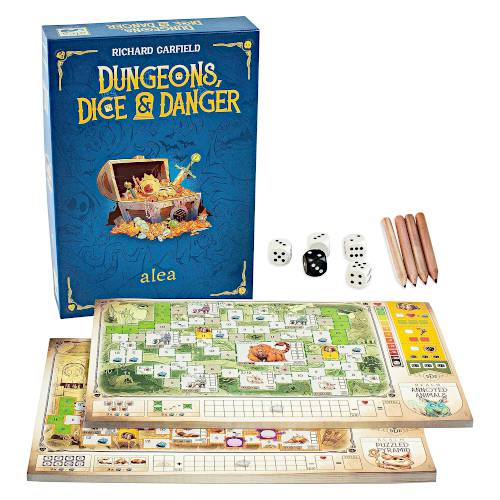
Designed by Richard Garfield
Supports 1 to 4 players
About 45 to 60 minutes
Simple complexity
Dungeons, Dice & Danger takes the paper-and-pencil concept and puts a fun dungeon crawling spin on it.
In this one, everyone plays on their own sheet of paper that shows a grid layout of rooms that comprise a dungeon. Each room has a number and the goal is to explore these rooms to find treasure and kill monsters.
Every round, the active player rolls 5 dice: 4 white dice and 1 black die. All players choose to pair the white dice however they want to get two results, and those numbers determine which rooms they can explore.
What's the black die for? Well, the active player—the one who rolled the dice—can substitute one of the white dice with the black die. This gives them a little more flexibility in exploring the dungeon.
Of course, it's not as simple as just pairing the right numbers. You can only explore rooms that are adjacent to rooms you've already explored. And if you can't explore any rooms using the dice results? You lose hit points! That means minus score at the end.
There are also monsters throughout the dungeon that you can attack by rolling the right numbers, which grant rewards when killed.
Dungeons, Dice & Danger is a fun and engaging experience that has a surprising amount of narrative energy to it, which is pretty unusual in the paper-and-pencil genre.
9. That's Pretty Clever!
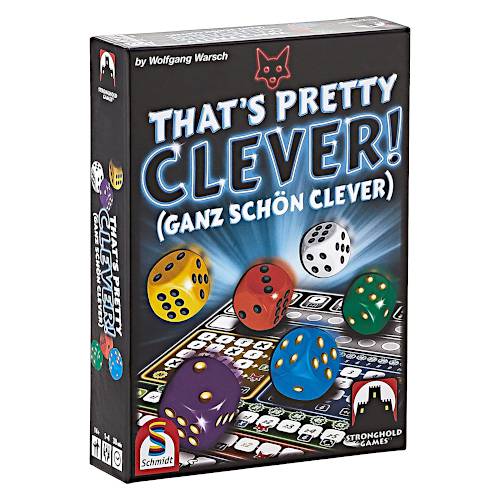
Designed by Wolfgang Warsch
Supports 1 to 4 players
About 20 to 30 minutes
Simple complexity
In the market for a roll-and-write game that feels very much like an abstract, thinky, mathy puzzle? Then you'll love That's Pretty Clever.
That's Pretty Clever is played using six dice of different colors: blue, green, yellow, orange, purple, and white. On your turn, you roll all the dice and then pick one to score on your personal sheet.
Each dice color scores in its own unique way. But more importantly, the different dice colors can sometimes trigger other areas of your sheet to score, resulting in chained scoring combos.
And there's another big twist: when you've chosen a die from your roll, all the other players can also choose to score any of the other dice with values lower than the one you chose. You might want that Green 6, but do you want to let everyone else advance on their sheet?
That's Pretty Clever is a numbers-heavy game without any theme, but that's not necessarily a bad thing. The puzzly gameplay is surprisingly fun and it tends to go over well with non-gamers.
8. Railroad Ink: Deep Blue Edition
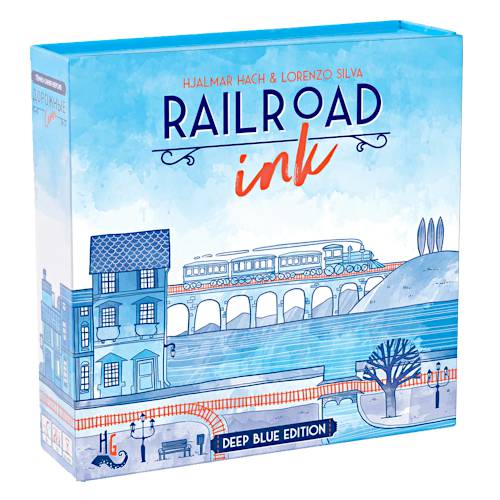
Designed by Hjalmar Hach and Lorenzo Silva
Supports 1 to 6 players
About 20 to 30 minutes
Simple complexity
Railroad Ink is an amazing little paper-and-pencil game that's more than just ticking off boxes on a sheet—it incorporates elements of drawing and spatial thinking to create a mesmerizing experience.
Every round, four custom dice are rolled. These dice have different images on each side corresponding to the tiles that you have to draw on your sheet. Each tile can be a road, a train track, or a combination.
Every player must draw all four of the tiles that were rolled, but it's up to you to decide where to place them and how you want to orient them.
Your goal is to fill up your 7x7 grid and successfully connect all the road and track entrances around the edge of the grid. There are also some special one-time abilities you can use if you get into trouble, plus a few other scoring opportunities beyond the grid itself.
7. Silver & Gold
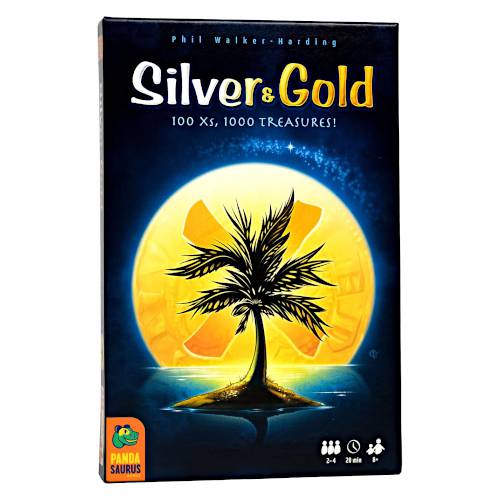
Designed by Phil Walker-Harding
Supports 2 to 4 players
About 15 to 20 minutes
Simple complexity
Silver & Gold is one of the best entry-level paper-and-pencil games out there. Not only is it extremely affordable, but it has an extremely simple ruleset that anyone can grasp within minutes.
You can think of Silver & Gold like a Tetris-style game, where you have your own little spatial puzzle cards that need to be filled out using shapes that are revealed (via card flips). If you can't fit the shape in your puzzle, then you can mark a single square instead.
Once you've filled out an entire puzzle, you put it aside and draft another puzzle card to work on. As cards are flipped and shapes are revealed, you fill your puzzles and rack up as many completions as you can. The harder the puzzle, the more points it's worth!
After a set number of rounds, whoever has the most points wins. You can also collect coins throughout the game that turn into trophies when you've collected enough, which adds a bit of a race element too.
The only downside to Silver & Gold is that it can't be played solo, which most paper-and-pencil games can be. However, if you never play solo and just want an easy option for family nights, this is a solid one.
6. Cartographers
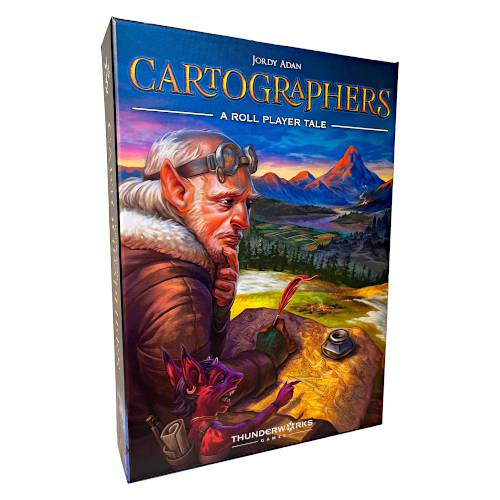
Designed by Jordy Adan
Supports 1 to 100 players
About 30 to 45 minutes
Moderate complexity
Cartographers is a paper-and-pencil game where you take on the role of a cartographer who's mapping out the terrain of a region.
The game is played over the course of four seasons—spring, summer, fall, winter—and each season has a different scoring objective that's randomized at the start of the game.
Every round, a card is flipped which contains a polyomino shape and two terrain types. Every player must fit the shape into their personal map grid, then fill in the shape with one of the terrain options.
When a season ends, players score their sheets according to how well their layouts meet the season's scoring objectives. After four seasons, whoever has the most points is the winner.
However, there are also monster shapes that might show up. These also get drawn to your map but they are worth negative points—unless you can completely surround them with your own terrain.
Cartographers isn't just a fun game but also a brilliant exercise in creativity. You can draw your terrain however you want and it's always so satisfying to see your finished map at the end.
5. Super-Skill Pinball: 4-Cade
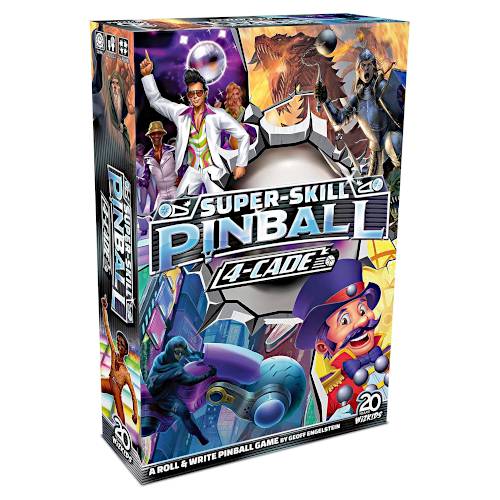
Designed by Geoff Engelstein
Supports 1 to 4 players
About 20 to 30 minutes
Moderate complexity
Wouldn't it be cool if a board game captured the frenetic thrills of a pinball machine? Well, such a game exists! It's called Super-Skill Pinball: 4-Cade and it really does feel like playing pinball.
In Super-Skill Pinball: 4-Cade, every player has their own sheet (that looks like a pinball machine) as well as a ball marker that starts at the top of the machine. This ball will be bouncing around the sheet—much like an actual pinball—with every round.
Each round, two regular dice are rolled. Players can individually choose which of the two dice they want to use. The value of your chosen die determines where your ball can move on your sheet.
As you bounce around, you'll mark off boxes and score combos and bonuses for accomplishing certain goals. You start with three lives, and if your ball ever drops to the bottom, you'll lose a life.
Super-Skill Pinball: 4-Cade is surprisingly addictive in how it brings the controlled chaos of pinball into the paper-and-pencil format.
The best part is that Super-Skill Pinball: 4-Cade comes with four different "machines" and each one plays radically differently with its own gameplay twists. You're getting four games in one box. Incredible!
4. Welcome to Your Perfect Home
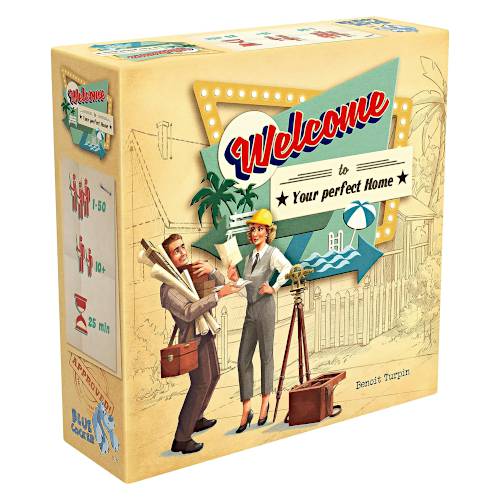
Designed by Benoit Turpin
Supports 1 to 100 players
About 20 to 30 minutes
Simple complexity
Welcome to Your Perfect Home (often shortened to simply Welcome To...) is the best introduction to the paper-and-pencil genre.
In this game, players have their own sheet of paper that represents their own housing development of three streets. The goal is to build out your streets with various amenities that each score in different ways.
Each street is comprised of houses numbered from 1 to 15. Houses must always be placed in ascending order but houses don't necessarily have to be consecutive in value. Some numbers are rarer than others.
Every round, you have a choice between three random pairs, where each pair consists of a house number and an amenity. Choose well to maximize the values of your streets while making sure you don't box yourself out by placing your numbers too tightly or too loosely.
This game is simple enough that even non-gamers can learn and play within minutes, but complex enough to have real depth and replayability. All of it is held together by a strong theme that shines.
Note: If you like the idea of Welcome to Your Perfect Home but want even more complexity, check out Welcome to the Moon.
Welcome to the Moon has the same core gameplay, but it's played across a campaign of eight sheets where one sheet affects the next and each sheet has its own twists to gameplay.
3. Long Shot: The Dice Game
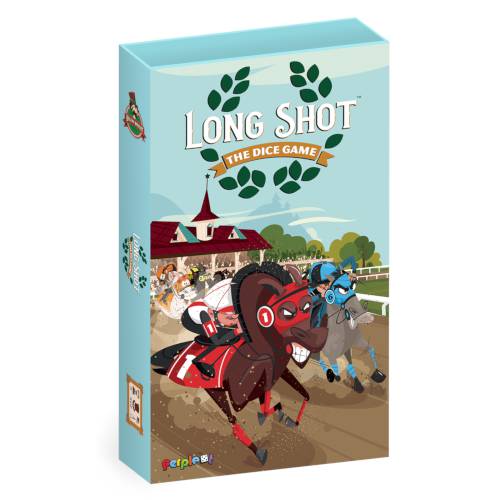
Designed by Chris Handy
Supports 1 to 8 players
About 20 to 40 minutes
Moderate complexity
Long Shot: The Dice Game is a wonderfully wacky game where players are betting on a horse race and trying to win more money than everyone else. It also happens to be one of the few roll-and-write games with a central board, which makes it feel a lot more like a game!
Every round, two dice are rolled: one corresponds to which horse gets moved and the other determines how many spaces that horse moves. (There are 8 horses and they can move up to 3 spaces per round.)
Each horse also has their own set of secondary horses that move whenever that horse is rolled to move—so multiple horses are always moving down the track every round.
Then, in turn order, each player can take one of their available actions. Maybe they place a bet on a horse. Maybe they mark a concession. Maybe they unlock another secondary horse on a horse. There's a lot to do in this game, which keeps it interesting!
In the end, Long Shot: The Dice Game isn't just a lucky betting game—it's a game about molding the odds and making smart tactical pivots as the horses progress down the track.
It's a paper-and-pencil game that feels wholly unique and offers more excitement than even most party-style games.
2. Dinosaur Island: Rawr 'n Write
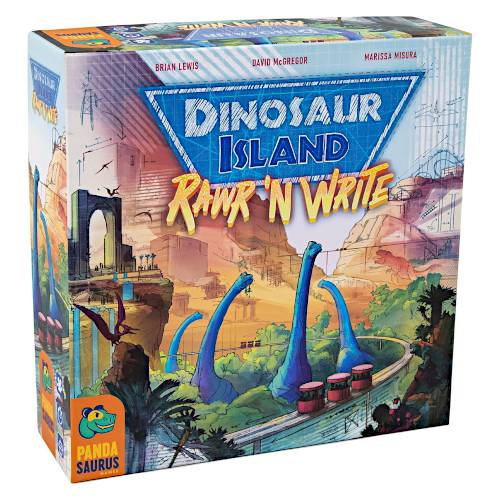
Designed by Brian Lewis, David McGregor, and Marissa Misura
Supports 1 to 4 players
About 30 to 60 minutes
Advanced complexity
Have you ever wanted to run your own island park full of dinosaurs? Dinosaur Island: Rawr 'n Write offers you that chance in this semi-complex game that mashes together several gameplay concepts.
Over the course of three rounds, you'll be acquiring resources, spending them on buildings and specialists, drawing those buildings in your personal grid layout, and running your dinosaur park.
Resources are acquired through a dice draft while buildings take on polyomino shapes that don't easily fit into your park layout. You'll also need to connect roads to exits to make your park even better.
On top of all that, you'll need to manage the threat level of the dinosaurs in your park AND the excitement levels of your park's visitors.
Dinosaur Island: Rawr 'n Write isn't necessarily a long game, but it's an elaborate experience that truly feels like you're in charge of a dinosaur theme park. It's one of the best roll-and-write games yet.
1. Hadrian's Wall
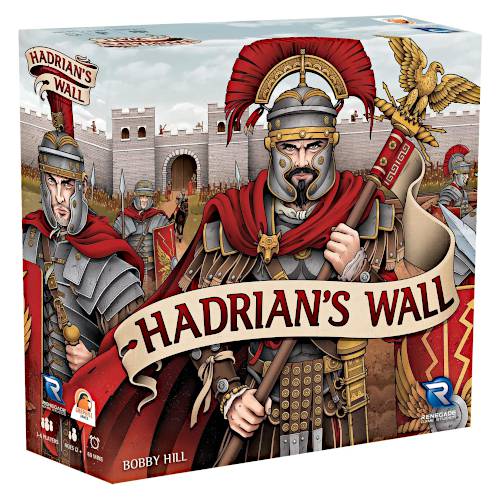
Warning: Hadrian's Wall is up there among the most complex paper-and-pencil games ever made. If you don't have experience playing heavy games with lots of moving parts, this one may be overwhelming. I only recommend it for serious, experienced gamers.
That said, the weight and complexity of Hadrian's Wall is earned. No move you make is ever simple. Different systems are intertwined and require you to manage multiple resource types for success.
It's all too complicated to run down fully in this article. Suffice it to say that the end goal is to gain the most points, and there are many paths (and combo-driven chains) that can get you there.
If you're looking for a deep, detailed, arduous, involved game that will seriously give your brain a mental workout, then you might consider Hadrian's Wall for your collection.
And while Hadrian's Wall technically supports up to six players, the weightiness of it—and the fact that you'll want time to think through your moves—makes it best as a solo experience.
